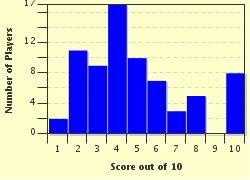Quiz Answer Key and Fun Facts
1. What is the name of the cheek bone?
2. Which of these bones forms the inferior portion of the nasal septum?
3. Which suture separates the two parietal bones from each other?
4. In which bone can the foramen magnum be found?
5. Which of these features is found on the mandible?
6. How many nasal concha are found in the nasal cavity?
7. Which of these features articulates with the first cervical vertebrae?
8. Which two bones make up the roof of the mouth?
9. Where are the pterygoid processes found?
10. Which of these is the largest fontanelle?
Source: Author
Cavaliersrock
This quiz was reviewed by FunTrivia editor
rossian before going online.
Any errors found in FunTrivia content are routinely corrected through our feedback system.


